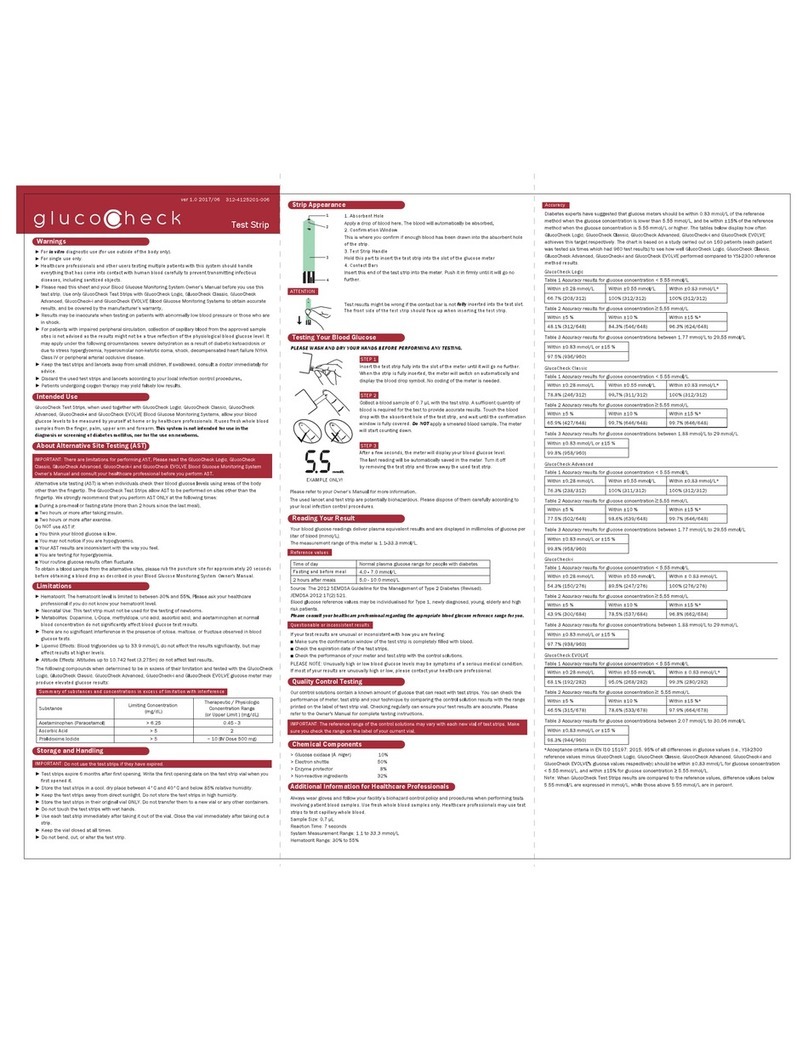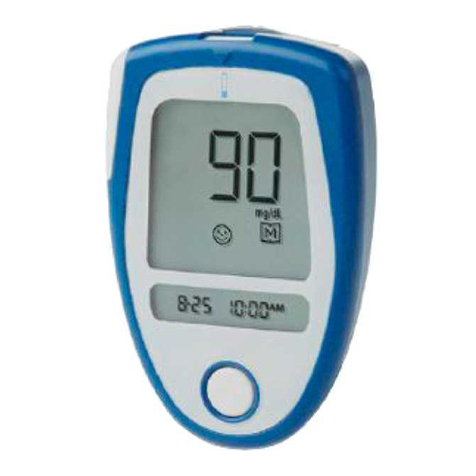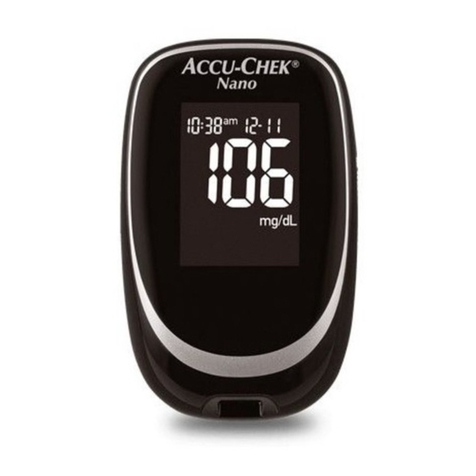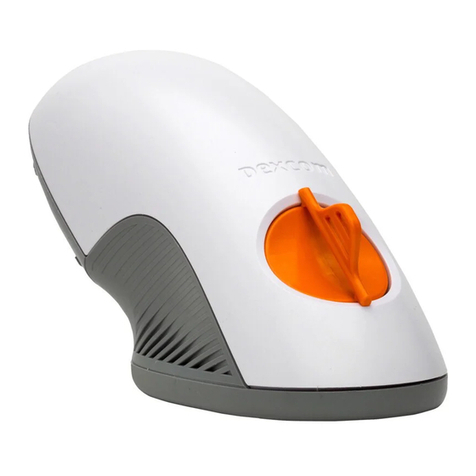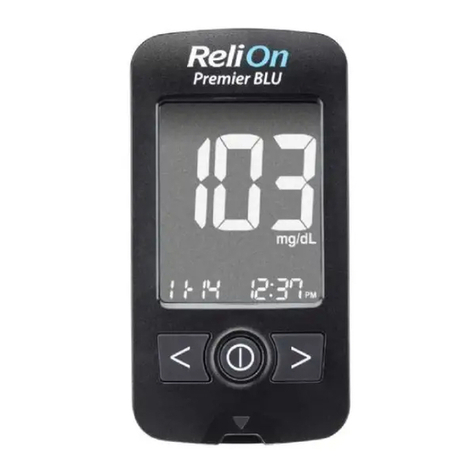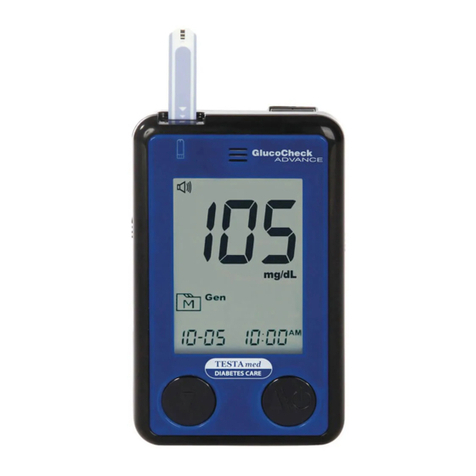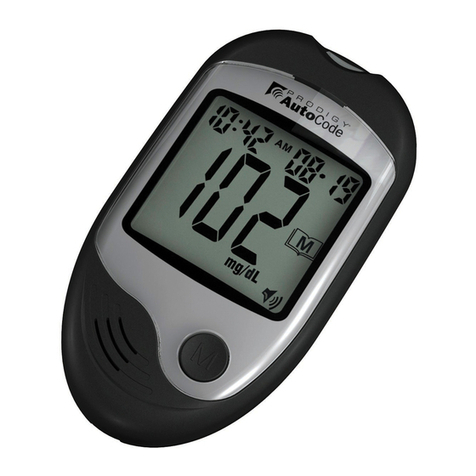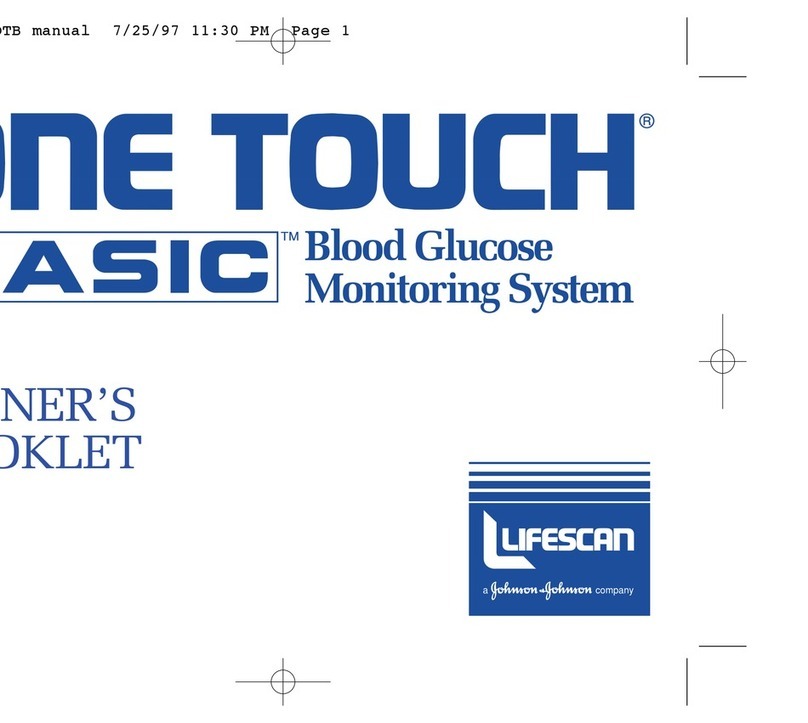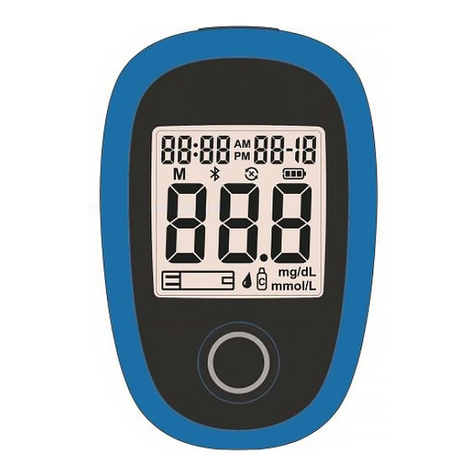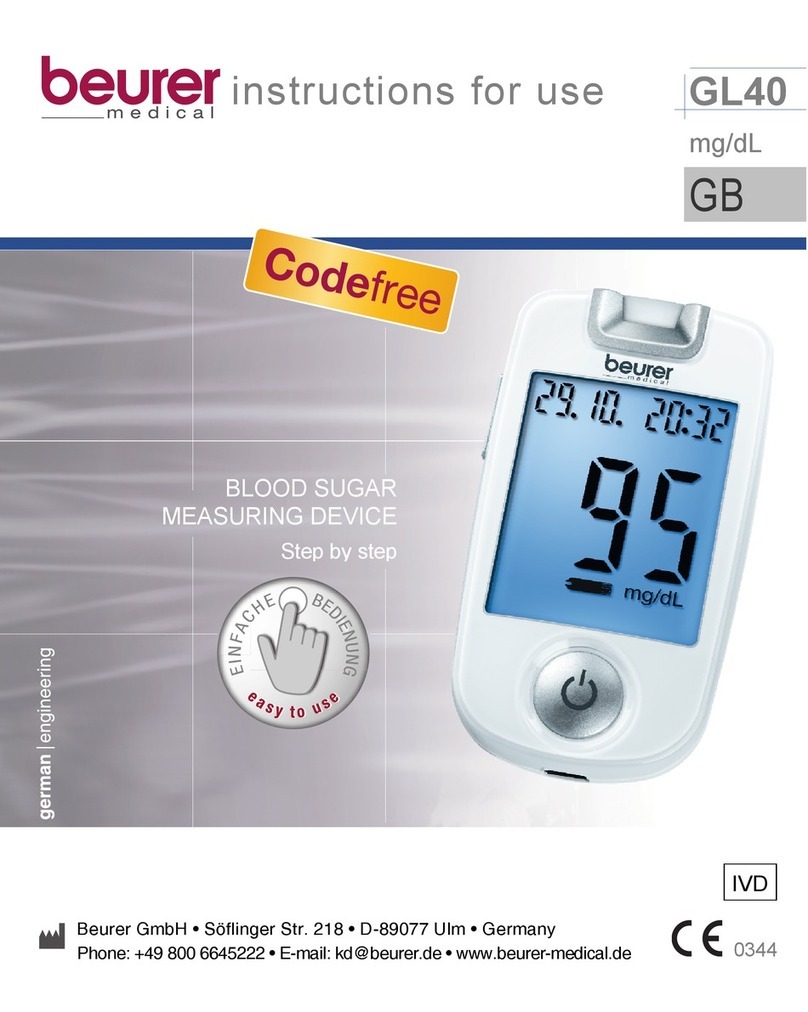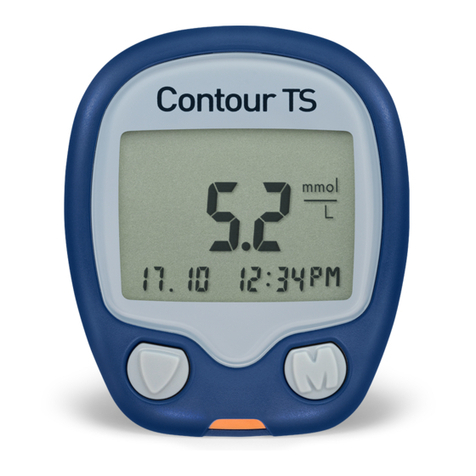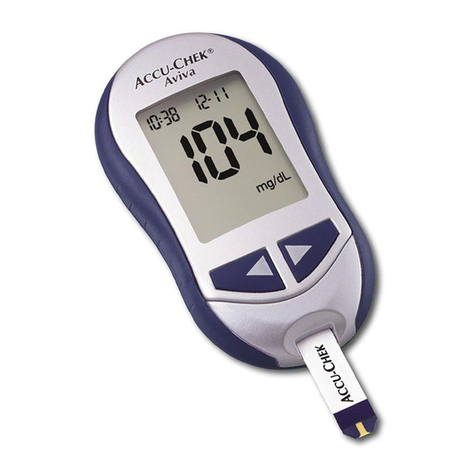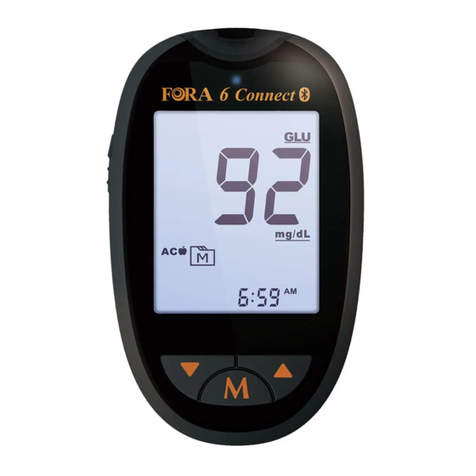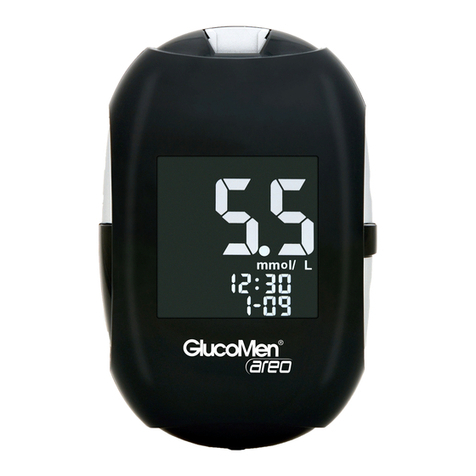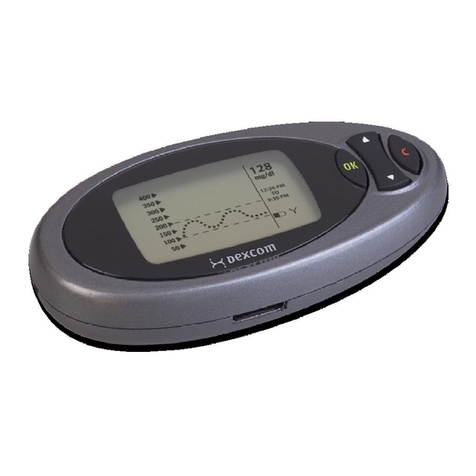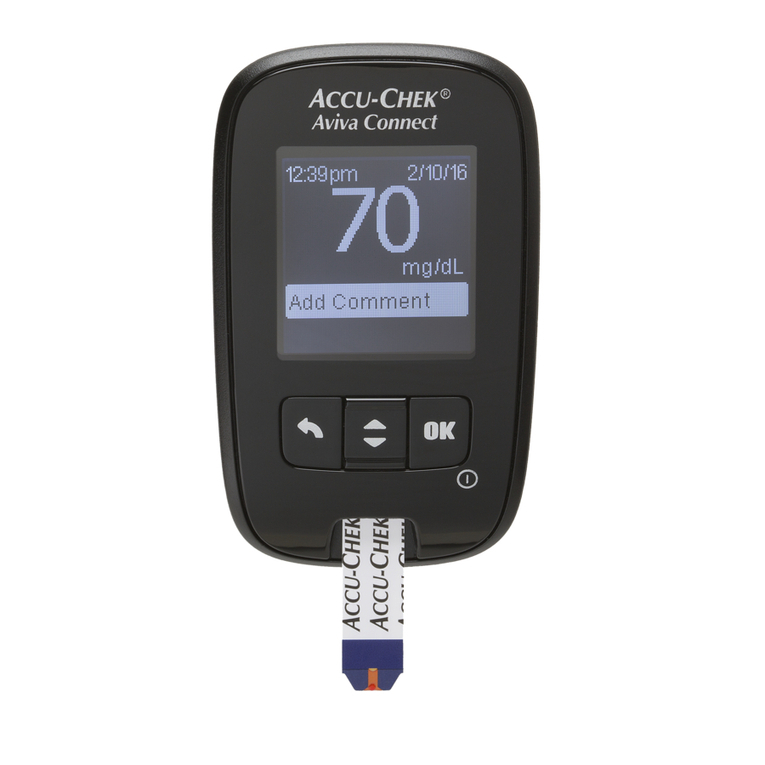GlucoCheck EVOLVE. User manual

OWNER'S MANUAL
Blood glucose monitoring system
GEMM ver 1.0 20170520


Thank you for purchasing the GlucoCheck Evolve Blood Glucose
Monitoring System. This manual provides important information to help
you to use the system. Please read the owner's manual thoroughly before
using this product.
Regular monitoring of your blood glucose levels can help you and
your doctor gain better control of your diabetes. Due to its compact
size and easy operation, you can use the GlucoCheck Evolve Blood Glucose
Monitoring System to easily monitor your blood glucose levels.
If you have any additional questions regarding this product, please
contact the place of purchase or Homemed (Pty) Ltd customer service on
0861 106 150.
Ver. 1.0 2017/06
311-XXXXXXX-XXX

IMPORTANT SAFETY INSTRUCTIONS
PLEASE READ BEFORE USE
1. Use this device ONLY for the intended use described in this manual.
2. Do NOT use accessories which are not specied by the manufacturer.
3. Do NOT use the device if it is not working properly or if it is damaged.
4. Do NOT use the equipment in places where aerosol sprays are being
used or where oxygen is being administered.
5. Do NOT under any circumstances use the device on newborns or
infants.
6. This device does NOT serve as a cure for any symptoms or diseases.
The data measured is for reference only. Always consult your doctor to have
the results interpreted.
7. Before using this device to test blood glucose, read all instructions
thoroughly and practice the test. Carry out all the quality control checks as
directed.
8. Keep the device and testing equipment away from young children.
Small items such as the battery cover, batteries, test strips, lancets and vial
caps are choking hazards.
9. Use of this instrument in a dry environment, especially if synthetic materials
are present (synthetic clothing, carpets etc.) may cause damaging static
discharges that may cause erroneous results.
10. Do NOT use this instrument in close proximity to sources of strong
electromagnetic radiation, as these may interfere with the accurate
operation.
11. Proper maintenance and a control solution test performed periodically is
essential to the longevity of your device. If you are concerned about the
accuracy of your measurements, please contact the place of purchase or
Homemed (Pty) Ltd for assistance.
KEEP THESE INSTRUCTIONS IN A SAFE PLACE

1
TABLE OF CONTENTS
BEFORE YOU BEGIN 2
Important Information 2
Intended Use 2
Meter Overview 3
Display Screen 4
Test Strip 4
SETTING THE METER 5
THE FOUR MEASURING MODES 7
BEFORE TESTING 8
Control Solution Testing 8
Performing a Control Solution Test 8
TESTING WITH A BLOOD SAMPLE 11
Preparing the Lancing Device for Blood Testing 11
Preparing the Puncture Site 11
Performing a Blood Glucose Test 12
Alternative Site Testing 15
METER MEMORY 16
Reviewing Test Results 16
Reviewing Blood Glucose Day Average Results 16
DOWNLOADING RESULTS ONTO A COMPUTER 18
MAINTENANCE 19
Batteries 19
Replacing the Batteries 19
Caring for Your Meter 20
Caring for Your Test Strips 20
Important Control Solution Information 21
SYSTEM TROUBLESHOOTING 22
Result Readings 22
Error Messages 23
Troubleshooting 24
DETAILED INFORMATION 26
SYMBOL INFORMATION 27
SPECIFICATIONS 28

2
BEFORE YOU BEGIN
Important Information
• Severe dehydration and excessive water loss may cause readings which
are lower than actual values. If you believe you are suering from severe
dehydration, consult a healthcare professional immediately.
• If your blood glucose results are lower or higher than usual, and you do not
have any symptoms of illness, rst repeat the test. If you do show symptoms
or continue to get results which are higher or lower than usual, follow the
treatment advice of your healthcare professional.
• Use only fresh whole blood samples to test your blood glucose. Using other
substances will lead to incorrect results.
• If you are experiencing symptoms that are inconsistent with your blood
glucose test results and you have followed all the instructions given in this
owner’s manual, contact your healthcare professional.
• We do not recommend using this product on severely hypotensive
individuals or patients in shock. Please consult with your healthcare
professional before use.
• The measurement unit used for indicating the concentration of blood or
plasma glucose is millimoles per litre (mmol/L).
Intended Use
This system is intended for use outside the body (in vitro diagnostic
use) by people with diabetes at home and by healthcare
professionals in clinical settings as an aid to monitoring the
eectiveness of diabetes control. It is intended to be used for the
quantitative measurement of glucose (sugar) in fresh whole blood
samples (from the nger, palm, forearm or upper arm).
It should not be used for the diagnosis or screening of diabetes, or
testing on newborns.

3
Display Screen
Test Strip Slot
Insert test strip here to switch the meter on for testing.
Strip Indicator Light
Light indicates the position of the test strip slot.
Test Strip Ejector
Eject the used test strip by sliding the button upwards.
Main Button (M)
Enter the meter memory and silence a reminder alarm.
Data Port
Download test results with a cable connection.
Battery Compartment
Uses 2x AAA batteries
SET Button (S)
Enter and conrm the meter settings.
1
2
3
5
4
6
7
8
Meter Overview
BACK FRONT SIDE

4
Display Screen
1
2
3
5
6
7
8
9
4
Test Result Alar ymbol
Measurement Unit
Ketone Warning
High/Low Indicator
Error Message
Low Battery Symbol
Test Strip Symbol
Measuring Mode
AC – before meal
PC – after meal
Gen – any time of day
Blood Drop Symbol
Memory Mode
Control Solution Mode
Date
Time
Face Symbol
Day Average
Test Strip Handle Contact Bars
10
11
12
13
14
1 2
3 4
15
16
Test Strip
ATTENTION:
The front side of the test strip should face up when
inserting the test strip into the meter.
Test results might be wrong if the contact bars are not
fully inserted into the test strip slot.
NOTE:
• The GlucoCheck EVOLVE meter should only be used with GlucoCheck Test
Strips. Using other test strips with this meter will produce inaccurate results.
mS
mS
QC-control solution test
(day-month)
1
2
3
4

5
SETTING THE METER
Before using your meter for the first time or after changing the meter
batteries, you should check and update the settings.
Entering the Setting Mode Mode
Start with the meter o (no test strip inserted).
1. Setting the date
The sequence of the date setting is: YEAR èMONTH èDAY.
With the YEAR / MONTH / DAY ashing in sequence, press the Main Button
(M) until the correct year/month/day appears. Press S.
2. Setting the time format
Press M to select the desired time format (12h or 24h). Press S.
3. Setting the time
With the HOUR / MINUTE ashing in sequence, press Muntil the
correct hour/minute appears. Press S.
4. Setting the low and high target range for measuring mode
The sequence of the low and high target range setting is
Gen low èGen high èAC low èAC high èPC low èPC high.
With the settings mentioned above ashing in sequence, press Muntil the
desired target appears. Press Sto conrm.
5. Deleting the memory
With “dEL” and “ ” on the display, press Mand select “no” to keep the
results in memory then press Sto skip. To delete all the results, press Mand
select “yes” to delete all the memory records.
Open the battery compartment and press the
Set Button (S).

6
6. Setting the reminder alarm
Your meter has four reminder alarms. The meter will display“OFF” and “ ”. If
you don’t want to set an alarm, press Sto skip this step. Or press Mto
select “On”, then press S.
With the hour/minute ashing in sequence, press Mto select the correct
hour/minute. Press Sand go to the next alarm setting.
NOTICE:
At the alarm time the meter will beep and automatically switch on. You can press
Mto silence the alarm. If you do not wish to perform a test, press and hold Mto
switch the meter o. If you do not silence the alarm, the meter will beep for 2
minutes then switch o.
Congratulations! You have completed all settings!
NOTE:
• These parameters can ONLY be changed in the setting mode.
• If the meter is idle for 2 minutes during the setting mode, it will switch o
automatically.

7
THE FOUR MEASURING MODES
The meter provides you with four modes for measuring: General, AC, PC and
QC.
You can switch between each mode as follows:
1. Start with the meter switched o. Insert a test strip to switch the meter on.
The screen will display a ashing“ ” and “Gen”.
2. Press Mto switch between General, AC, PC and QC mode.
MODES
General
(displays as “Gen”)
AC
PC
QC
USE WHEN
any time of day without regard to time since last
meal
before a meal
2 hours after a meal
testing with the control solution

8
BEFORE TESTING
Control Solution Testing
Our Control Solution contains a known amount of glucose that reacts
with test strips. By comparing the result of your control solution test with the
expected range printed on the test strip vial label, you can check that the meter
and test strips are working together as a system and that you are performing
the test correctly.
Do a control solution test when:
• you rst receive the meter,
• at least once a week to routinely check the meter and test strips,
• you start using a new vial of test strips,
• you suspect the meter or test strips are not working properly,
• your blood glucose test results are not consistent with how you feel, or if
you think the results are not accurate,
• practicing the testing procedure, or
• you have dropped or think you may have damaged the meter.
Performing a Control Solution Test
To perform a control solution test, you will need:
1 Meter 2 Test Strip 3 Control Solution
1. Insert the test strip to switch the meter on
Insert the test strip into the meter. Wait for the meter to display
“ ” and “ ”.

9
2. Press M to mark this test as a control solution test
Press Muntil “QC” is displayed on the screen, to ensure that the test result
is not stored in the meter memory. If you press Magain, the “QC” will
disappear and this test is no longer a control solution test.
WARNING:
• When performing a control solution test, you have to mark it accordingly
to ensure that the test result is not stored in the meter memory. Failure to
do so will result in the control solution test result being included with your
blood glucose test results in memory.
3. Apply control solution
Shake the control solution bottle thoroughly before use. Squeeze out the
rst drop and wipe it o, then squeeze out another drop and place it on the
tip of the bottle cap. Hold the meter to move the absorbent hole of the test
strip to touch the drop. Once the conrmation window lls completely, the
meter will start counting down.
NOTE:
• To avoid contaminating the control solution, do not directly apply control
solution onto a strip.
4. Read and compare the result
After counting down to 0, the control solution test result will appear on the
display. Compare this result with the range printed on the test strip vial – it
should fall within this range. If not, please read the instructions again and
repeat the control solution test.

10
Out-of-range results:
If the meter continues to display results outside the range printed on the test
strip vial, the meter and/or strips may be faulty. Please contact Homemed (Pty)
Ltd customer service on 0861 106 150 for assistance.
NOTE:
• The control solution range printed on the test strip vial is for control
solution use only. It is not a recommended range for your blood glucose
level.
• See the MAINTENANCE section for important information about your
control solutions.

11
TESTING WITH A BLOOD SAMPLE
Warning:
To reduce the chance of infection:
• Never share a lancet or lancing device.
• Always use a new, sterile lancet. Lancets are for single use only.
• Avoid getting hand lotion, oil, dirt or debris in or on the lancets and lancing
device.
Preparing the Lancing Device for Blood Testing
Please follow the instructions in the lancing device insert for collecting a blood
sample.
Preparing the Puncture Site
Stimulating blood circulation by rubbing the puncture site before obtaining a
blood sample has a signicant inuence on the glucose value obtained.
Please follow the suggestions below before obtaining a drop of
blood:
• Wash and dry your hands before starting.
• Select the puncture site either at ngertips or alternative puncture site
(please see section Alternative Site Testing (AST) on how to select the
appropriate sites).
• Rub the puncture site for about 20 seconds before penetration.
• Clean the puncture site using cotton moistened with 70% alcohol and let it
air dry.
• Fingertip testing
Press the lancing device’s tip rmly against
the lower side of your ngertip. Press the
release button to prick your nger – a click
indicates the puncture is complete.

12
• Blood from sites other than the ngertip
Replace the lancing device cap with the clear
cap for AST. Pull the cocking control back until
it clicks. When lancing the forearm, upper
arm, or palm, avoid lancing areas with obvious
veins to prevent excessive bleeding.
NOTE:
• Choose a dierent spot each time you test. Repeated punctures at the same
spot may cause soreness and calluses.
• Please consult your healthcare professional before you perform AST.
• It is recommended that you discard the rst drop of blood as it might
contain tissue uid, which may aect the test result.
Performing A Blood Glucose Test
To perform a blood glucose test, you will need:
1 Meter 2 Test Strip 3 Lancing Device
1. Insert the test strip to switch the meter on
Wait for the meter to display“ ” and “ ”.
2. Select the appropriate measuring mode by pressing M.
1
2

13
3. The Four Measuring Modes
For selecting the measurement mode, please refer to The Four Measuring
Modes section.
4. Obtaining a blood sample
Use the pre-set lancing device to puncture the desired site. Wipe o the rst
drop of blood that appears with a clean cotton swab. Gently squeeze the
punctured area to obtain another drop of blood. Be careful not to smear the
blood sample. The size of the drop should be at least as big as • actual size,
which is 0.7 microliter (μL) of volume.
5. Apply the sample
Gently insert the test strip into the blood
sample, at a tilted angle. The absorbent hole
of the test strip will absorb the blood sample
until the conrmation window completely lled.
Do NOT remove your nger until you hear a beep sound.
NOTE:
• Do not press the punctured site against the test strip or try to smear the blood.
• If you do not apply a blood sample to the test strip within 2 minutes, the
meter will automatically switch o. You will need to remove and reinsert the
test strip to start a new test.
• The conrmation window should be lled with blood before the meter
starts to count down.
• Adding blood to the test strip should be done in one single action. NEVER
try to add more blood to the test strip once it has been removed from the
test site or the " " sign has disappeared from the screen. Discard the used
test strip and retest with a new one.
• If you experience issues whilst performing the test procedure, please
contact your healthcare professional or Homemed (Pty) Ltd for assistance.

14
6. Read Your Result
The result of your blood glucose test will appear after the meter counts
down to 0. The blood glucose result will automatically be stored in the
meter memory.
7. Eject the used test strip
Eject the test strip by sliding the eject
button upwards. The meter will switch
o automatically.
WARNING:
• Always follow the instructions in the lancing device insert when removing
the lancet.
• The used lancet and test strip may be biohazardous. Please dispose of them
carefully according to your local infection control procedures.

15
Important:
There are limitations with Alternative Site Testing (AST).
Please consult with your healthcare professional before you perform AST.
Suggested Test Areas
for the Hand
Forearm
Upper Arm
Alternative Site Testing
You can test on a variety of locations
on your body.
When to use AST?
Food, medication, illness, stress and exercise can aect blood glucose levels.
Capillary blood at the ngertip reects these changes faster than capillary
blood at other sites. Thus, when testing blood glucose during or immediately
after a meal, physical exercise, or any other event, take a blood sample from
your nger only.
We strongly recommend that you perform AST ONLY at the following times:
• In a pre-meal or fasting state (more than 2 hours since the last meal).
• Two hours or more after taking insulin.
• Two hours or more after exercise.
Do NOT use AST if:
• You think your blood glucose is low.
• You are unaware of hypoglycemia.
• You are testing for hyperglycemia.
• Your AST results do not match the way you feel.
• Your routine glucose results often uctuate.

16
METER MEMORY
The meter stores the 450 most recent blood glucose test results
along with respective dates and times in its memory. To enter the
meter memory, start with the meter switched o.
Reviewing Test Results
1. Press and release M.
" ” will appear on the display. Press Magain, and the rst reading
displayed is the last blood glucose result along with date, time and the
measurement mode.
2. Press M to recall the test results stored in the meter each time you press.
After the last test result, press M again and the meter will be switched o.
Alternatively you can press and hold M for 5 seconds to switch o the meter.
Reviewing Blood Glucose Day Average Results
1. Press and release M. When “ ” appears on the display, keep Mpressed in
for 3 seconds until the ashing“ DAY AVG ” appears. Release M– your 7-day
average result measured in general mode will appear on the display.
2. Press M to review 14-, 21-, 28-, 60- and 90-day average results stored in
each measuring mode in the order of Gen, AC, then PC.
3. Exit the meter memory.
Keep pressing M– the meter will switch o after displaying the last test
result.
Table of contents
Other GlucoCheck Blood Glucose Meter manuals
